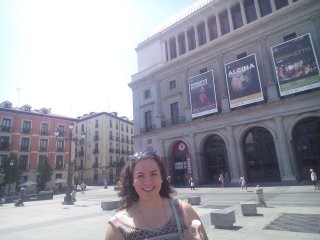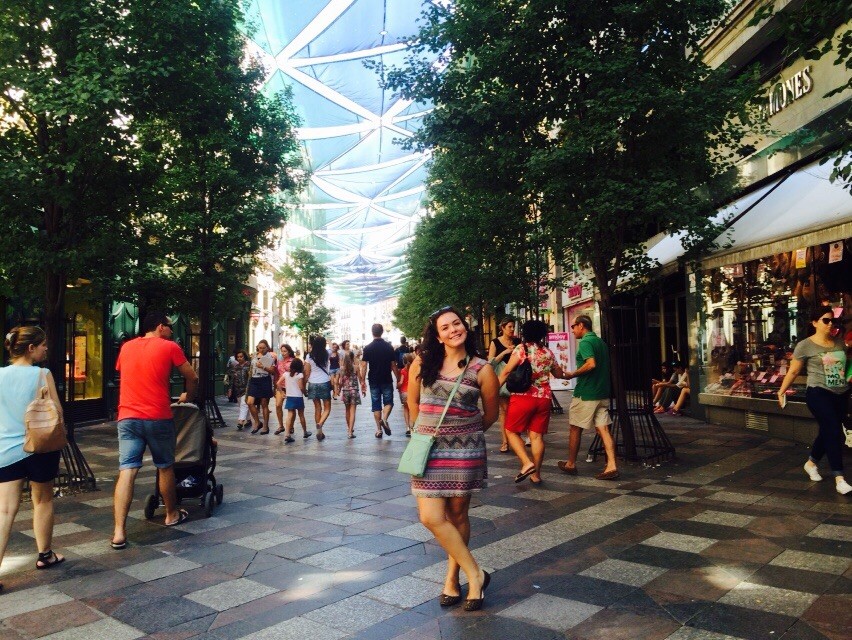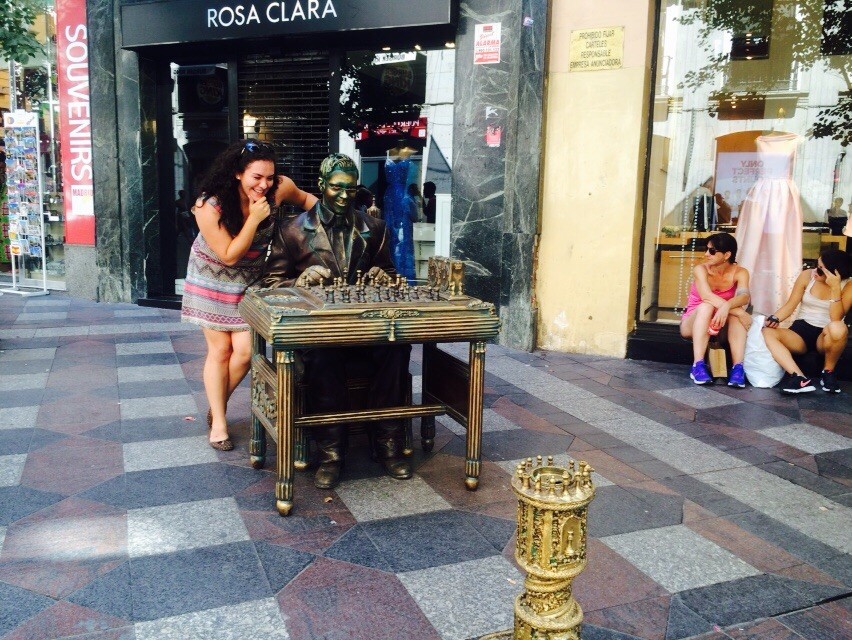Although the square's official name is Plaza Isabel II, a significantly large number of Madrid's citizens know it as Ópera. In fact, if you ask for directions or information about this square, it's possible that some people don't know where it is. This is one of the most representative squares of the "old" Madrid, the Madrid de los Reyes, and, to this day, is still being very well-preserved and is one of the places that attracts more tourists for being situated right in-between the Royal Palace and the Plaza del Sol.

(A panoramic photograph of Plaza Isabel II: you can see the Teatro Real to the left, and Ópera metro station just off-centre in the foreground. )
A brief history of the square
It's difficult to believe that such an elegant square like this one was once the area's washing site and had a fountain with more than 50 basins to provide water for both drinking and washing purposes. They have actually preserved some of the pieces of this fountain and these are currently exhibited in the underground museum. You will also be able to find a replica fountain that was built to replace the one now found in the museum.
One of the things that really grabbed my attention was knowing that, right where this square is, was where the Christian Walls of Madrid were also located, which are also known as "La Puerta de Valnadú". However, it comes with a history that saw it demolished by Philip II in 1567 in order to build a new wall that would act as a door. Close to the square, you can see a sign which has some facts about it and states exactly where the wall was located.
This square has suffered many modifications, not only in its structure, but also to its name, as it was previously known as Plaza de Prim (or, 'Prim', for short) or Plaza del Barranco, for the surrounding area having served as a defensive zone. Its definitive name (and it wasn't even definitive, as the citizens later changed it) was granted with the construction of the Teatro Real and the urbanisation works in the area by orders of Queen Isabel II. So, it's for this very reason that the square bears her name, despite being known as Plaza de la Ópera by the locals due to the Teatro Real being located within the square itself.
Museo de los Caños del Peral
You won't believe it, but this museum is actually located within the metro station and exhibits many of the pieces found in the square, including the remains of the old fountain that I described earlier.
Teatro Real (Opera House)
This theatre is what gives the Plaza de Ópera that "must-see" label, as it is one of the most emblematic and important places in Spain.
The Teatro Real is over 150 years old, as it was inaugurated in 1850, and for a long period of time, there were performances every single day until there was a prolonged downturn between 1926 and 1966.

(Teatro Real in the background)
However, the theatre is no longer used for opera-type functions, and instead, symphony concerts are what consistently dominate its scheduling nowadays. Another of the reasons why people come to visit the theatre is due to the guided tours offered. Given that the Teatro Real has such artistic importance, many people value it as being the headquarters of widely recognised performances on a global level, like concerts by the Berlin Philharmonic and Richard Strauss, as well as when Ballet Russes performed Stravinsky's renowned ballet, Petrushka.
The square as a leisure, art and cultural area
This is one of those squares that grabs your attention from the very first moment that you see it, as it acts as one of the main leisure and culture areas in the city. The second time I went, I remember seeing lots of people organised and grouped together, which made me think that there was a protest going on. But, right as I stopped next to the line of people to find out what was going on, I realised that I had stumbled across a film shoot. At that very moment, they were filming scenes for a new Spanish film that was due to be released in the following months. I was surprised to see that a large number of the pedestrians were going crazy; they told me that one of the guys in the scene was a famous Spanish actor. In fact, it's not the first time that I have seen movies or TV series being filmed in this area.
If you want to do some shopping, this is the perfect area to do so, as just a few short metres away, you will find Calle Arenal. This is an exclusively pedestrianised street with some of the best clothing stores (including the official Real Madrid shop, for example), phone cases, traditional tapas restaurants, cosmetics, and souvenirs, if it happens that you are looking for something small to take back home for your relatives.

(The elegance of Calle Arenal)
Churros at San Ginés
Situated just a few metres away from the Plaza de Ópera is the chocolate shop, San Ginés, which is very famous for being over a hundred years old and for having played host to many important artistic and historical figures. The shop is open 24 hours a day, 7 days a week, 365 days a year, and, by going there, you will be able to be a part of one of Madrid's most famous traditions: eating churros with hot chocolate. To get there, you must follow Calle Arenal until you reach the fourth cross-street, before turning right down Pasadizo de San Ginés. If you want a more detailed description, you can check out the review I wrote about this chocolate shop on my profile.
The parties come to life at the weekend
This square is a first-hand witness to the nightlife that young people in Madrid have come to enjoy, especially at weekends. If you decide to visit it on a Sunday, you will see the atmosphere it has, as there are people who literally live and breathe tourism by dressing up to attract the attention of large crowds. Despite working informally, these people are the ones who entertain the tourists the most. You only have to just look at their elaborate and original costumes before you want to take a photo with them. Mind you, they ask for a "voluntary" contribution for the photo, which, in reality, is more of a compulsory contribution, but it's worth it considering the hours they spend dressed like that.

(Cultural richness in Calle Arenal)
How much does it cost to visit?
The square is a public place, so your experience there will be free. However, if you want to take a tour of the Teatro Real, it will cost you either 8€, as the standard admission price, or a reduced rate of 6€ in the event that you are a pensioner or a students. Children can visit for free.
If you want to visit the Museo de los Caños del Peral, you will only have to pay the cost of getting there via the metro, as the museum is located just inside the station. A metro ticket costs anywhere between 1. 50€ and 3€, depending on the route taken and your station of origin.
When is the best time to go there?
The best thing about this place is that there is no specific time nor day that's considered as the "ideal" time to go, as there is always something going on in the square, even in the early hours of the morning. If you worried about how safe it is at night, it's important for you to know that there are police cars stationed along the pedestrianised streets all night long, as well as police officers walking around ready to attend to any problems or incidents that may arise.
How do you get there?
If you want to travel by metro:
Take the red line (Line 2) and alight at Ópera. If you want to visit the museum, don't leave the station because you can access it directly from inside here.
If you want to travel by bus:
The two bus routes that will drop you off right by the square are the 25 and the 31. It will be easy to get there because Ópera is the final stop on both of these routes, so don't be scared about having missed the stop if you aren't paying attention.
If you want to travel by bike:
Madrid has a bicycle-sharing scheme, BiciMAD, which is available for the general public to use, and is much cheaper to use than the bus or metro. This system will only allow you to see the centre of Madrid, where you will find parking stations every so often. You must know that the bicycles are very safe, and in the case that you start to feel tired, you can start using a function that powers up a motor - they are really worth using. You will find a parking station just next to the Teatro Real.
If you want to walk there:
This is one of my preferred options, as Madrid is such a small city that you can see all of its emblematic sites following just a single route.
I recommend the following route: Plaza de España -> Palacio Real -> Ópera -> Sol -> Gran Vía -> Cibeles -> Parque El Retiro.
If you want to travel by Cercanías Renfe:
Cercanías is a type of suburban train that connects the neighbouring villages with the city. This system has less stations than the metro does, so to get to the square, you will have to walk to Príncipe Pío station to then take the metro from Ramal Príncipe Pío to Ópera.
 What to see Madrid,
Madrid,
Spain
What to see Madrid,
Madrid,
Spain























